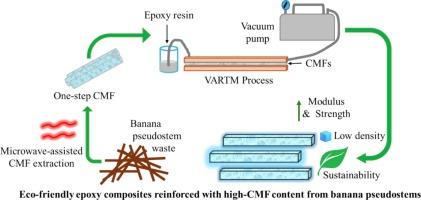香蕉假茎高含量纤维素微原纤维增强环氧复合材料力学性能的改善
Q1 Environmental Science
引用次数: 0
摘要
利用农业废弃物作为增强材料的高性能结构杂化聚合物生物复合材料的开发正在推动一个更可持续的产业的发展。本研究采用快速、环保的微波辅助方法从香蕉假茎残基中提取纤维素微原纤维(CMFs)。提取的CMFs结晶度高(92%),热稳定性在349℃以上,直径范围在7 ~ 13 μm之间。使用真空辅助树脂转移成型(VARTM)工艺将这些CMFs以60%的重量掺入层压环氧复合材料中。以市售环氧树脂双酚A二缩水甘油酯醚(BADGE)为基体。与依赖商业编织纤维垫的传统系统不同,非织造CMFs成功地集成在一起,没有结块或结构缺陷。与纯环氧树脂相比,复合材料的杨氏模量增加63%(从893到1456 MPa),抗拉强度提高57%(从32.4到51.04 MPa)。动态力学分析表明,在较宽的温度范围内,储能模量和损耗模量增加,tan δ峰变宽,表明能量耗散增强。差示扫描量热法证实了与玻璃化转变温度相关的尖锐放热转变的存在。SEM分析表明,复合材料表面弥散均匀,与基体的界面附着力强。尽管CMF含量很高,但复合材料保留了环氧树脂体系的低密度特性,并且由于增强剂的极性性质而表现出更高的保水性。该策略为将农业残留物转化为轻质结构复合材料提供了技术上和环境上可行的途径。开发的材料符合循环经济和绿色化学原则,在汽车、建筑、船舶和技术制造领域显示出强大的应用潜力。本文章由计算机程序翻译,如有差异,请以英文原文为准。

Improved mechanical properties in laminated epoxy composites reinforced with high-content cellulose microfibrils from banana pseudostems
The development of high-performance structural hybrid polymeric biocomposites using agricultural waste as reinforcement is driving progress toward a more sustainable industry. In this study, cellulose microfibrils (CMFs) were extracted from banana pseudostem residues using a rapid and eco-friendly microwave-assisted method. The extracted CMFs exhibited a high crystallinity index (92 %), thermal stability above 349 °C, and diameters ranging from 7 to 13 μm.
These CMFs were incorporated at 60 wt% into laminated epoxy composites using a vacuum-assisted resin transfer molding (VARTM) process. Diglycidyl ether of bisphenol A (BADGE), a commercially available epoxy resin, was used as the matrix. Unlike conventional systems that rely on commercial woven fiber mats, the non-woven CMFs were successfully integrated without agglomeration or structural defects. The resulting composites showed a 63 % increase in Young's modulus (from 893 to 1456 MPa) and a 57 % improvement in tensile strength (from 32.4 to 51.04 MPa) compared to neat epoxy resin. Dynamic mechanical analysis revealed increases in storage and loss moduli and a broadened tan δ peak, indicating enhanced energy dissipation over a wide temperature range. Differential scanning calorimetry confirmed the presence of a sharp exothermic transition associated with the glass transition temperature. SEM analysis revealed uniform dispersion of CMFs and strong interfacial adhesion with the matrix.
Despite the high CMF content, the composite retained the low density characteristic of epoxy systems and exhibited increased water retention due to the polar nature of the reinforcement. This strategy offers a technically and environmentally viable route for converting agricultural residues into lightweight structural composites. The developed materials align with circular economy and green chemistry principles and show strong potential for applications in the automotive, construction, marine, and technical manufacturing sectors.
求助全文
通过发布文献求助,成功后即可免费获取论文全文。
去求助
来源期刊

Bioresource Technology Reports
Environmental Science-Environmental Engineering
CiteScore
7.20
自引率
0.00%
发文量
390
审稿时长
28 days
 求助内容:
求助内容: 应助结果提醒方式:
应助结果提醒方式:


